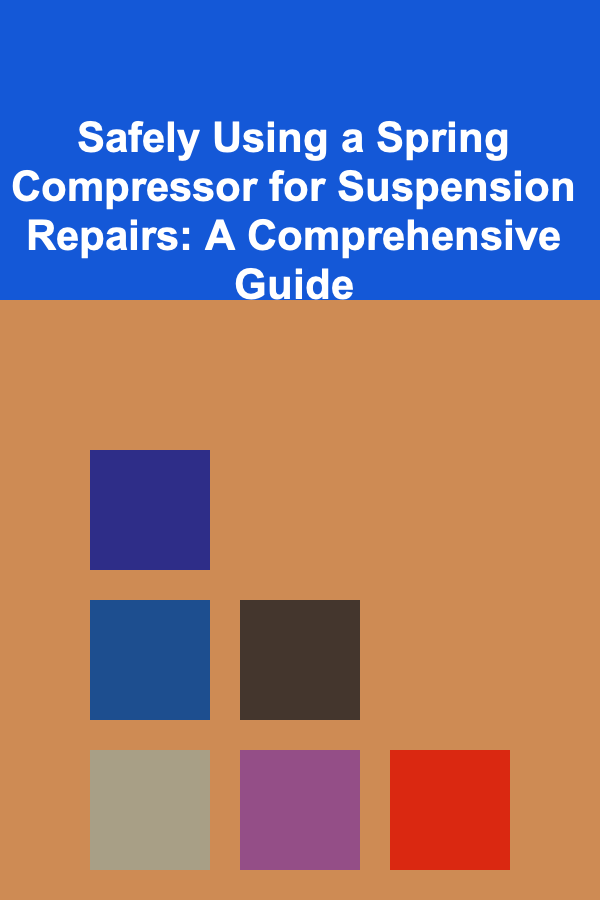
Safely Using a Spring Compressor for Suspension Repairs: A Comprehensive Guide
ebook include PDF & Audio bundle (Micro Guide)
$12.99$7.99
Limited Time Offer! Order within the next:

Suspension repairs are a common part of vehicle maintenance, and often involve working with coil springs. These springs are under significant tension, making them potentially dangerous if mishandled. A spring compressor is a specialized tool designed to safely compress these springs, allowing for strut replacement, shock absorber changes, or other suspension work. However, using a spring compressor incorrectly can lead to serious injury or even death. This guide provides a comprehensive overview of how to use a spring compressor safely and effectively for suspension repairs.
Understanding the Risks Involved
Before delving into the how-to, it's crucial to understand the dangers associated with coil springs. Coil springs store a tremendous amount of energy. When compressed, they are under immense pressure. If a spring compressor fails or the spring is released unexpectedly, this energy can be released violently, propelling the spring with considerable force. This can cause severe blunt force trauma, lacerations, broken bones, and even fatal injuries. Therefore, strict adherence to safety precautions is absolutely paramount.
Common risks include:
- Spring Slippage: The spring dislodges from the compressor jaws during compression or decompression.
- Compressor Failure: The compressor itself breaks or fails due to overloading, material defects, or improper use.
- Improper Positioning: The compressor is not correctly positioned on the spring, leading to uneven compression and potential instability.
- Operator Error: Incorrect use of the compressor, such as over-tightening or failing to secure the spring properly.
- Using the Wrong Type of Compressor: Using a compressor not designed for the specific spring size or type.
Choosing the Right Spring Compressor
Not all spring compressors are created equal. Selecting the appropriate compressor for the job is the first step in ensuring safety. There are two main types of spring compressors commonly used:
- Internal Spring Compressors (Strut Spring Compressors): These compressors are designed to be used on the vehicle, requiring specialized tools and experience. They typically involve two or more forks that grip the inside of the spring coil. While sometimes faster, they can be more challenging to use safely, especially for beginners. They're often used when access to the strut assembly is limited.
- External Spring Compressors (MacPherson Strut Spring Compressors): These compressors are the most common type and are typically used with the strut assembly removed from the vehicle. They feature two or more adjustable jaws or clamps that grip the outside of the spring coil. These are generally considered safer and easier to use for DIY mechanics.
Consider the following factors when choosing a spring compressor:
- Vehicle Type: Different vehicles have different suspension designs and spring sizes. Ensure the compressor is compatible with your vehicle's make and model. Check the compressor's specifications for its load capacity and spring diameter range.
- Spring Type: The coil springs on your vehicle could have different coils and diameters. Verify that the compressor can handle the type and size of spring you need to compress.
- Quality and Construction: Invest in a high-quality compressor from a reputable manufacturer. Look for sturdy construction, durable materials, and a reliable locking mechanism. Avoid cheap, poorly made compressors, as they are more likely to fail.
- User Reviews and Ratings: Research online reviews and ratings to get feedback from other users about the compressor's performance and safety. Pay attention to any reported issues with slippage, breakage, or difficulty of use.
- Safety Features: Look for compressors with features such as safety pins, locking mechanisms, and overload protection. These features can help prevent accidental spring release and protect against compressor failure.
- For most DIY mechanics working in their garage, an external spring compressor is the safer and more practical choice.
Essential Safety Precautions
- Safety is paramount when working with spring compressors. Adhere to these precautions:
- Read the Instructions: Carefully read and understand the manufacturer's instructions for your specific spring compressor model before starting any work. Each compressor has its own operating procedures and safety guidelines.
- Wear Proper Personal Protective Equipment (PPE):
- Safety Glasses or Face Shield: Protect your eyes from flying debris.
- Gloves: Protect your hands from sharp edges and potential pinching.
- Sturdy Footwear: Protect your feet in case the spring falls. Steel-toed boots are highly recommended.
- Work in a Safe Environment:
- Clear the Area: Ensure a clear and uncluttered workspace. Remove any unnecessary tools, objects, or personnel from the immediate area.
- Secure the Strut Assembly: If using an external compressor, secure the strut assembly in a vise or on a sturdy workbench.
- Work Away from Others: Perform the compression and decompression process away from other people. Maintain a safe distance to minimize the risk of injury to bystanders.
- Inspect the Compressor: Before each use, thoroughly inspect the spring compressor for any signs of damage, wear, or corrosion. Check the threads, jaws, and locking mechanisms for cracks, bends, or stripped threads. If you find any defects, do not use the compressor.
- Use the Correct Tools: Use the correct tools for operating the spring compressor. Do not use makeshift tools or pliers, as they can slip or break.
Step-by-Step Guide to Using an External Spring Compressor Safely
- This guide focuses on using an external (MacPherson strut) spring compressor, as it's the most common and generally safer option for DIYers. Always refer to your specific compressor's instructions for detailed guidance.
- Preparation:
- Remove the Strut Assembly: Safely remove the strut assembly from the vehicle following the manufacturer's instructions. Ensure the vehicle is properly supported on jack stands.
- Secure the Strut: Place the strut assembly in a sturdy vise or on a workbench, ensuring it is securely held in place. Consider using a strut spring compressor stand for added stability. Avoid damaging the strut body during clamping.
- Gather Your Tools: Have all necessary tools readily available, including the spring compressor, appropriate wrenches, safety glasses, gloves, and a clean rag.
- Position the Compressor Jaws:
- Even Distribution: Place the compressor jaws on opposite sides of the spring, ensuring they are evenly spaced. Ideally, position them as far apart as possible to distribute the compression force evenly and prevent spring bending.
- Proper Grip: Make sure the jaws are securely gripping the spring coils. The jaws should be fully engaged on the spring, and the safety pins (if present) should be properly inserted to prevent slippage.
- Avoid End Coils: Do not position the jaws too close to the ends of the spring, as this can cause them to slip or damage the spring.
- Compress the Spring Gradually:
- Incremental Compression: Compress the spring gradually, alternating between the two jaws. Tighten each jaw a small amount at a time, ensuring the spring remains straight and evenly compressed.
- Observe Spring Alignment: Constantly monitor the spring's alignment during compression. If the spring starts to bend or buckle, stop immediately and reposition the jaws.
- Lubricate Threads: Apply a small amount of lubricant to the compressor's threads to make tightening easier and prevent binding.
- Avoid Over-Compression: Only compress the spring enough to safely remove the strut mount. Over-compression can damage the spring or cause the compressor to fail.
- Remove the Strut Mount:
- Loosen the Nut: Once the spring is compressed sufficiently, carefully loosen the nut on top of the strut mount. This nut is often very tight and may require a breaker bar.
- Secure the Mount: Hold the strut mount securely while removing the nut, as it can come loose suddenly. Consider using a second person to assist.
- Remove the Mount: Carefully remove the strut mount, bearing, and other components from the strut rod. Note the order of these components for reassembly.
- Decompress the Spring Slowly and Carefully:
- Gradual Release: Slowly and gradually release the tension on the spring, alternating between the two jaws. Do not release the tension all at once.
- Constant Monitoring: Constantly monitor the spring's alignment and the compressor's stability during decompression.
- Listen for Unusual Noises: Listen for any unusual noises, such as popping or cracking, which could indicate a problem. Stop immediately if you hear anything suspicious.
- Maintain Control: Maintain control of the spring at all times during decompression. Be prepared to react quickly if the spring starts to slip or become unstable.
- Reassembly:
- Follow Reverse Order: Reassemble the strut assembly in the reverse order of disassembly, ensuring all components are properly aligned and securely fastened.
- Torque Specifications: Torque all nuts and bolts to the manufacturer's specifications.
- Preparation:
Common Mistakes to Avoid
- Several common mistakes can lead to accidents when using a spring compressor. Be aware of these pitfalls and take steps to avoid them:
- Using a Damaged or Worn Compressor: Never use a compressor that is damaged, worn, or shows signs of corrosion. Damaged compressors are more likely to fail under load.
- Over-Tightening the Compressor: Over-tightening the compressor can damage the spring or cause the compressor to fail. Only compress the spring enough to safely remove the strut mount.
- Uneven Compression: Uneven compression can cause the spring to bend or buckle, increasing the risk of slippage. Ensure the jaws are evenly spaced and that the spring remains straight during compression.
- Improper Jaw Placement: Improper jaw placement can cause the spring to slip or damage the spring coils. Ensure the jaws are securely gripping the spring and are not positioned too close to the ends of the spring.
- Rushing the Process: Rushing the compression or decompression process can lead to mistakes and accidents. Take your time and work carefully.
- Ignoring Safety Precautions: Ignoring safety precautions, such as wearing safety glasses or working in a clear workspace, can increase the risk of injury.
- Using the Wrong Compressor Type: Using a compressor not designed for the specific spring type or size is extremely dangerous.
Dealing with Stuck or Corroded Components
- Sometimes, strut components, particularly the nut on the strut rod, can be seized or heavily corroded, making disassembly difficult. Here's how to address these situations:
- Penetrating Oil: Apply a generous amount of penetrating oil to the nut and surrounding area. Allow it to soak for several hours, or even overnight, to loosen corrosion.
- Heat (Use with Caution): If penetrating oil doesn't work, carefully apply heat to the nut using a propane torch. Heat can expand the metal and break the corrosion bond. However, be extremely cautious when using heat near flammable materials and ensure adequate ventilation. Do not overheat the nut, as this can weaken it.
- Impact Wrench: Use an impact wrench with the appropriate socket to loosen the nut. The rapid, powerful impacts of the impact wrench can often break free seized components.
- Strut Nut Socket: A specialized strut nut socket is designed to hold the strut rod in place while you loosen the nut. This prevents the strut rod from spinning and makes removal easier.
- Damaged Nut Removal: If the nut is severely damaged, you may need to use a nut splitter or a cutting torch to remove it. Exercise extreme caution when using these tools, as they can be dangerous if not used properly.
Maintenance of Your Spring Compressor
- Proper maintenance of your spring compressor is crucial for its longevity and safety. Regular inspection and maintenance can help prevent failures and ensure the tool operates correctly.
- Cleaning: After each use, clean the compressor thoroughly with a clean rag. Remove any dirt, grease, or debris that may have accumulated on the threads, jaws, or other components.
- Lubrication: Lubricate the threads of the compressor with a high-quality lubricant. This will help prevent binding and ensure smooth operation.
- Inspection: Regularly inspect the compressor for any signs of damage, wear, or corrosion. Check the threads, jaws, and locking mechanisms for cracks, bends, or stripped threads.
- Storage: Store the compressor in a dry, safe place where it will not be exposed to extreme temperatures or humidity.
- Replacement Parts: If any parts of the compressor are damaged or worn, replace them immediately. Do not attempt to repair damaged parts, as this can compromise the safety of the tool.
When to Seek Professional Help
- While DIY suspension work can save money, it's essential to recognize your limitations. Certain situations warrant professional assistance:
- Lack of Experience: If you are not comfortable working with spring compressors or suspension components, seek professional help.
- Damaged Suspension Components: If you discover damaged suspension components during disassembly, consult a mechanic.
- Specialized Tools Required: If the repair requires specialized tools that you do not have, it may be best to take the vehicle to a professional.
- Vehicle-Specific Procedures: Some vehicles have unique suspension designs that require specialized knowledge or procedures.
- If Anything Feels Unsafe: If at any point during the process you feel unsafe or unsure, stop immediately and seek professional assistance. Your safety and the safety of others should always be the top priority.
Conclusion
- Using a spring compressor safely requires careful planning, the right tools, and strict adherence to safety precautions. By understanding the risks involved, choosing the appropriate compressor, and following the steps outlined in this guide, you can safely perform suspension repairs and maintain your vehicle's performance. Remember, safety is always the top priority. If you are unsure about any aspect of the process, seek professional assistance.

How to Choose the Right Pet Supplies for Your Home
Read More
How to Make Money Online as a CRM Administrator: 10 Actionable Ideas
Read More
How to Set Up Your Amazon Seller Account for Custom Products
Read More
How to Use Overhead Storage to Free Up Living Areas
Read More
Understanding the Evolution of Robotics
Read More
The Art and Science of Homemade Jams and Preserves: A Comprehensive Guide
Read MoreOther Products

How to Choose the Right Pet Supplies for Your Home
Read More
How to Make Money Online as a CRM Administrator: 10 Actionable Ideas
Read More
How to Set Up Your Amazon Seller Account for Custom Products
Read More
How to Use Overhead Storage to Free Up Living Areas
Read More
Understanding the Evolution of Robotics
Read More